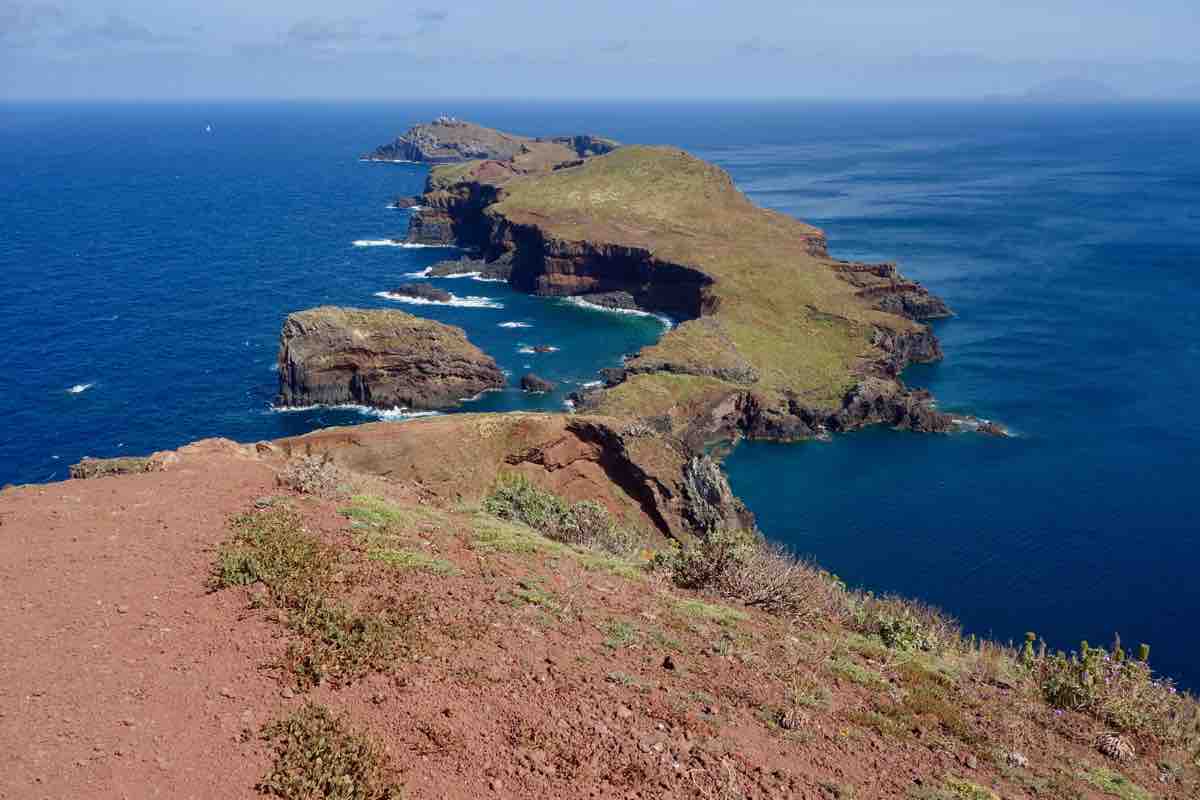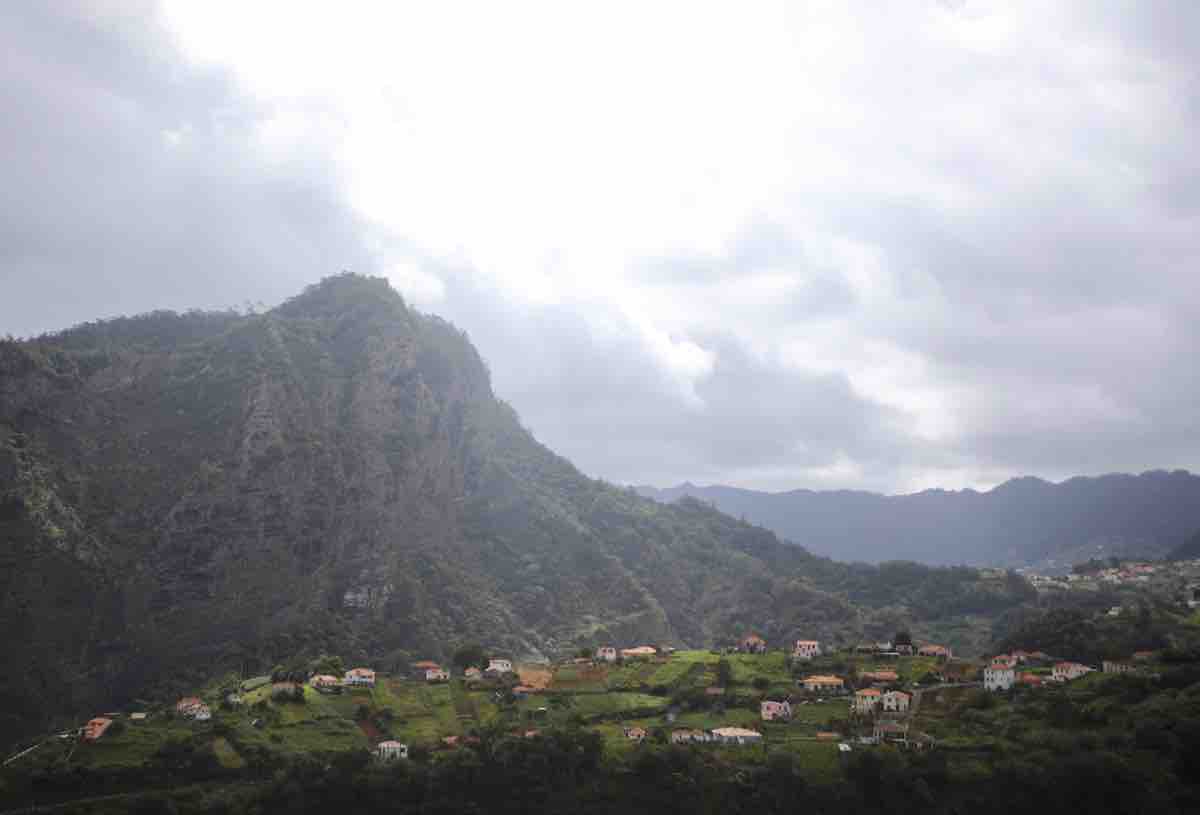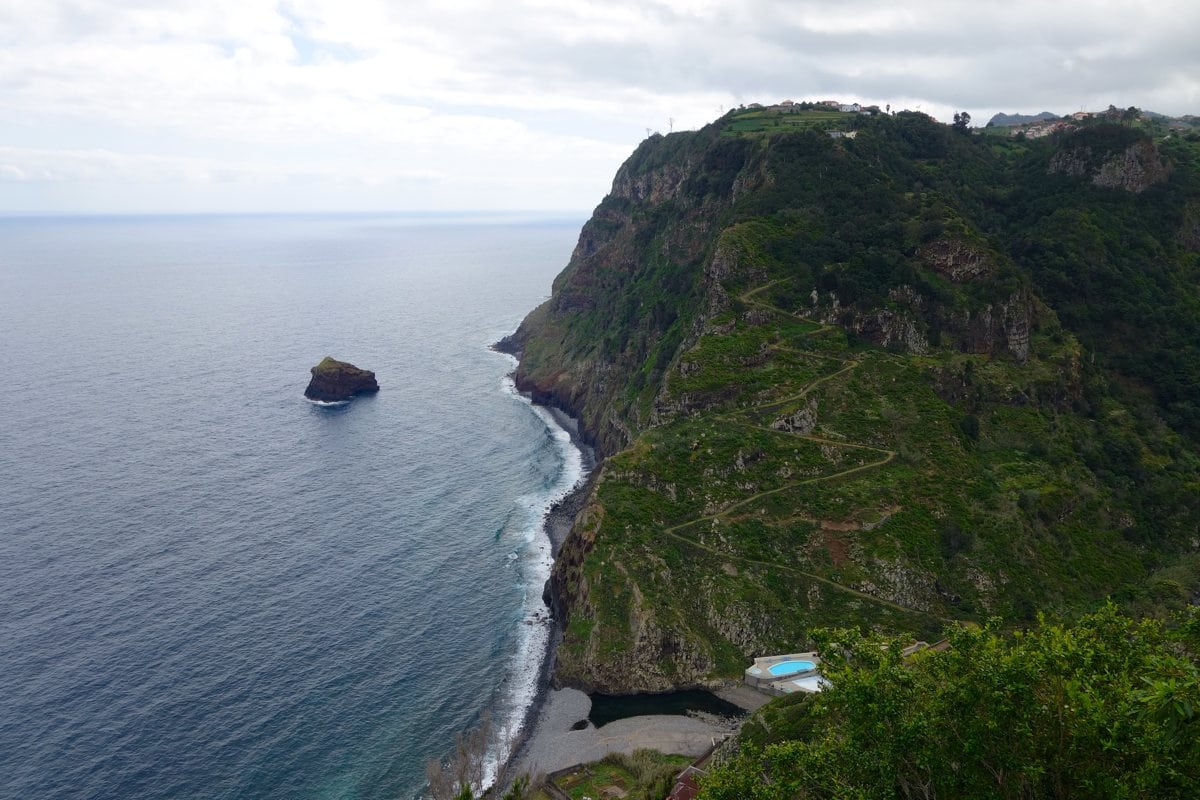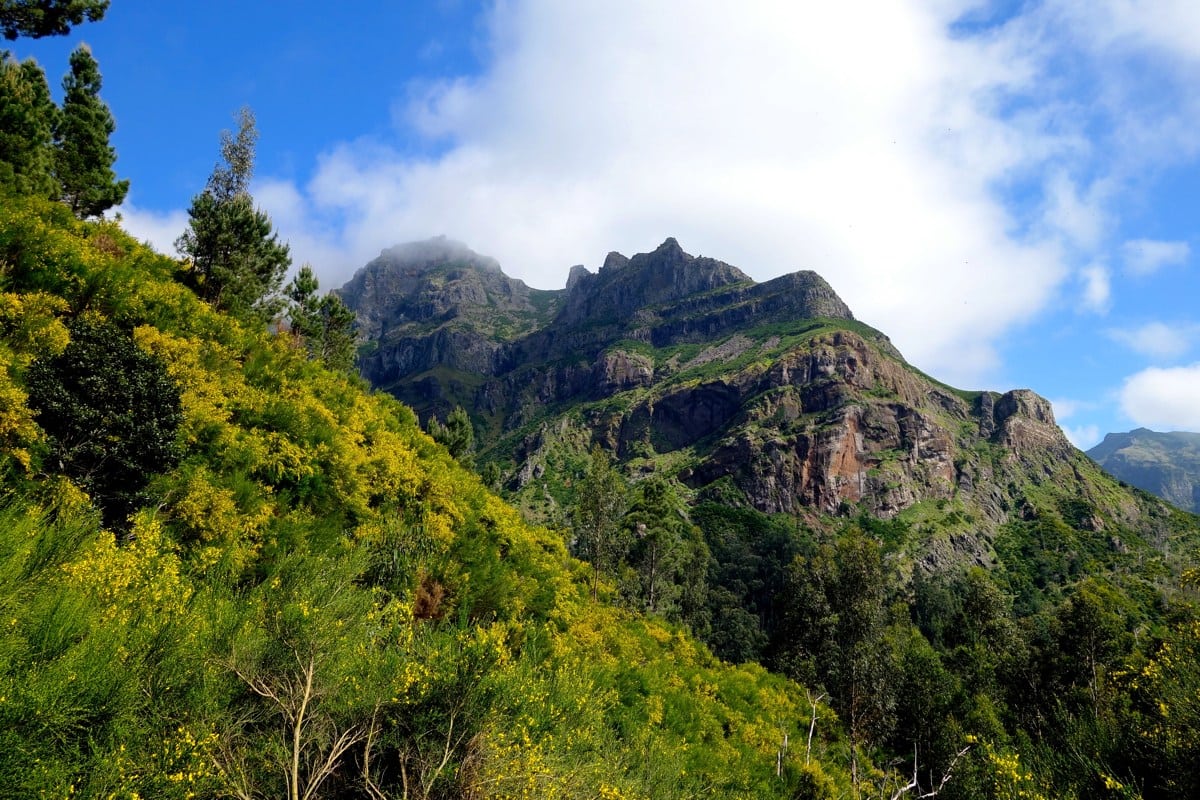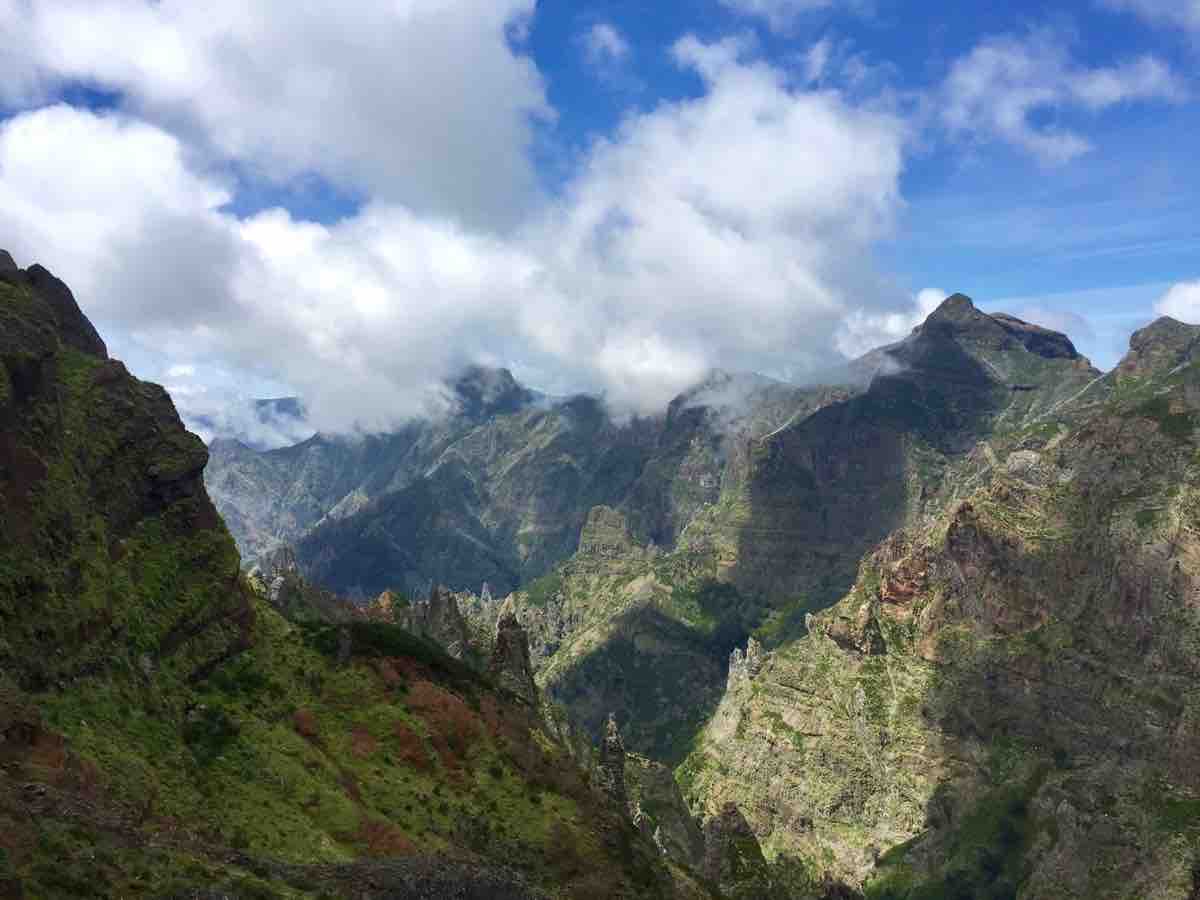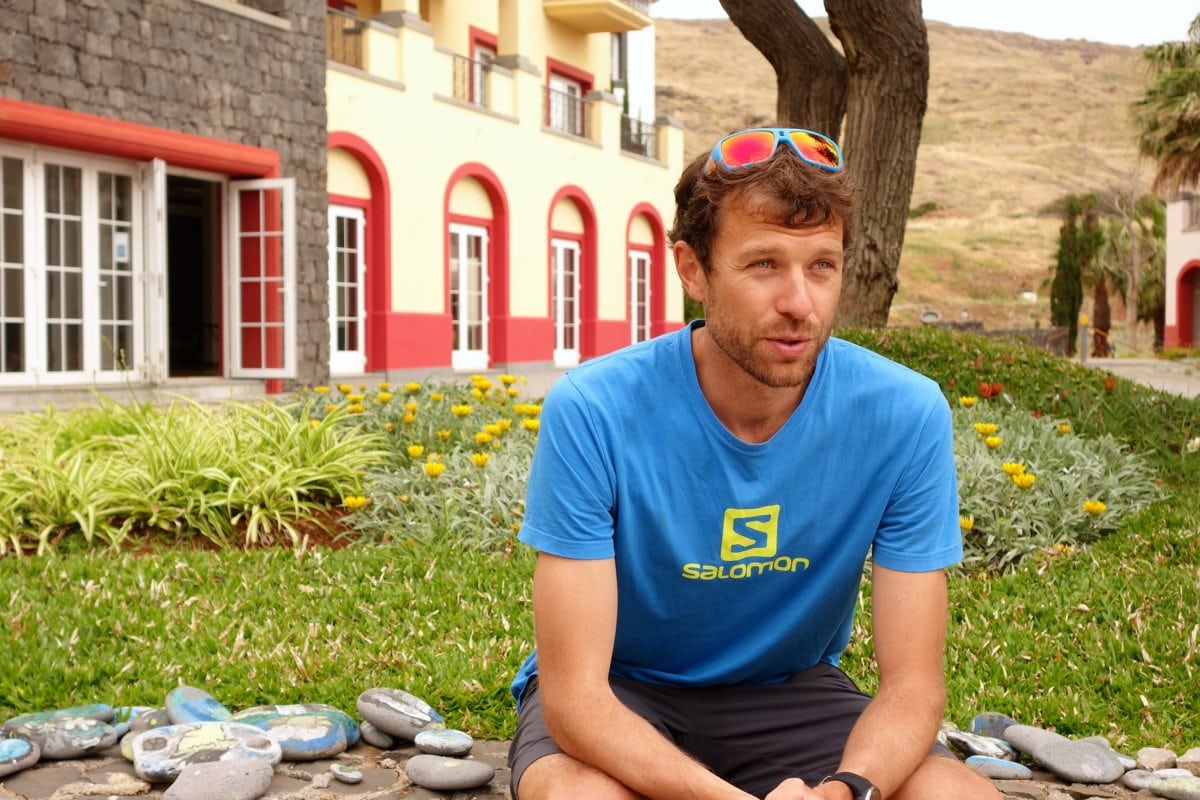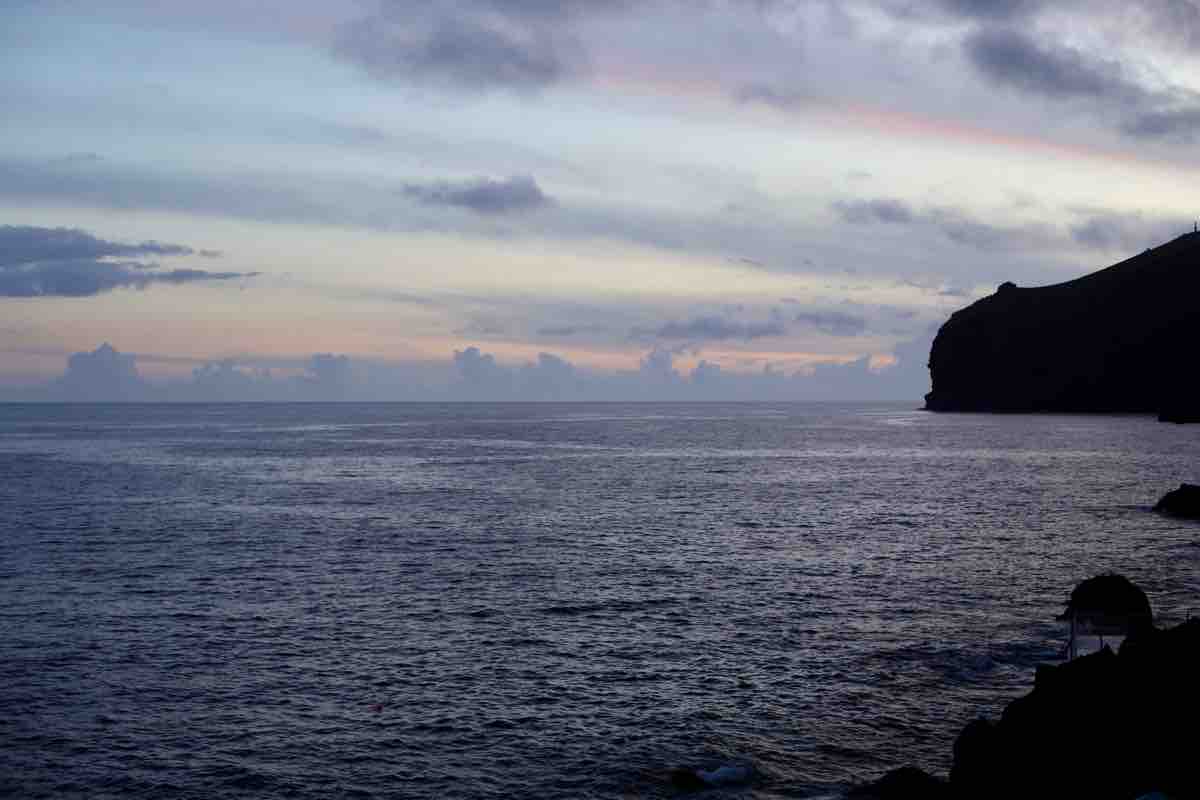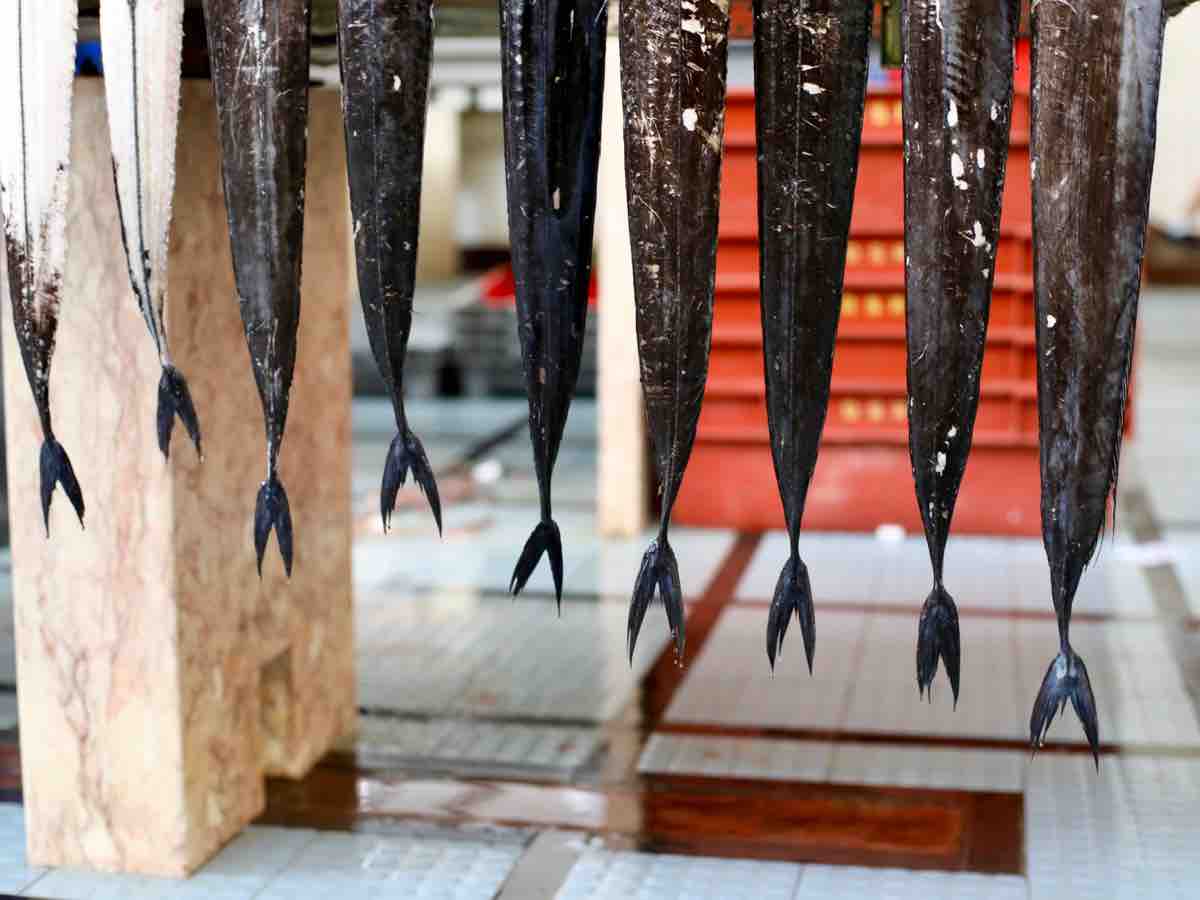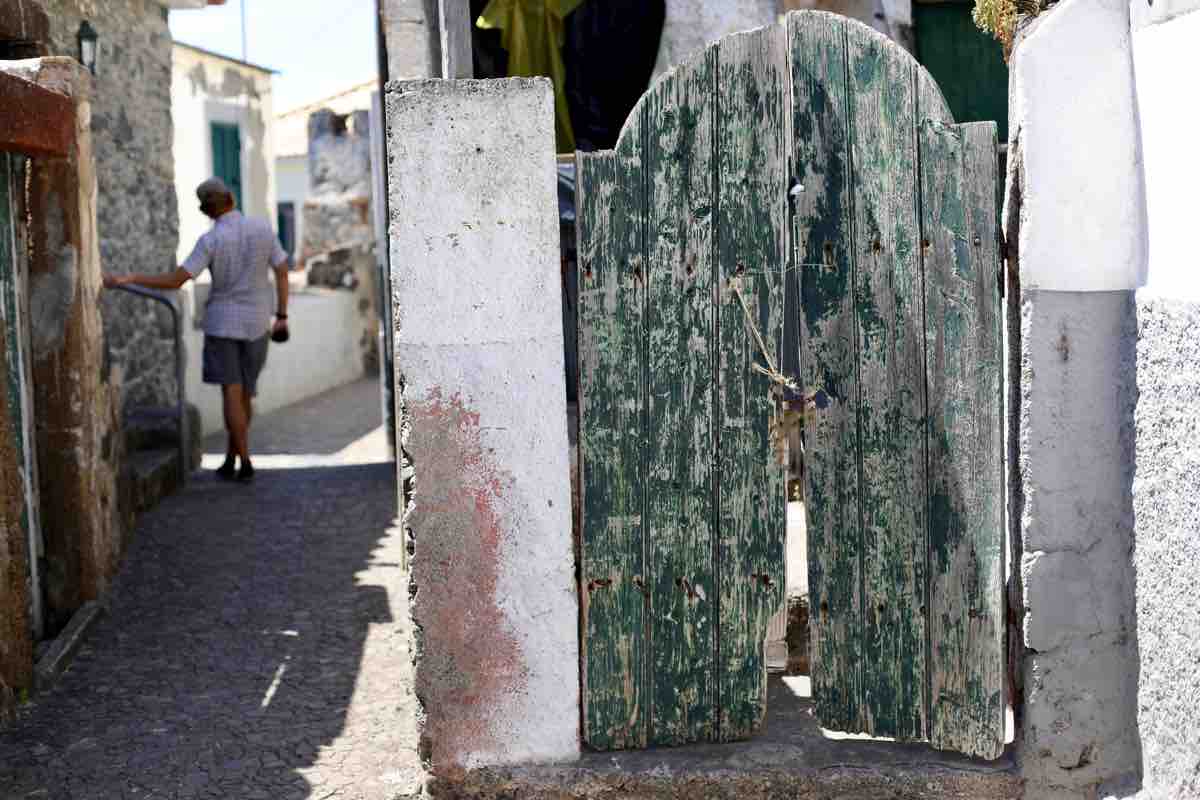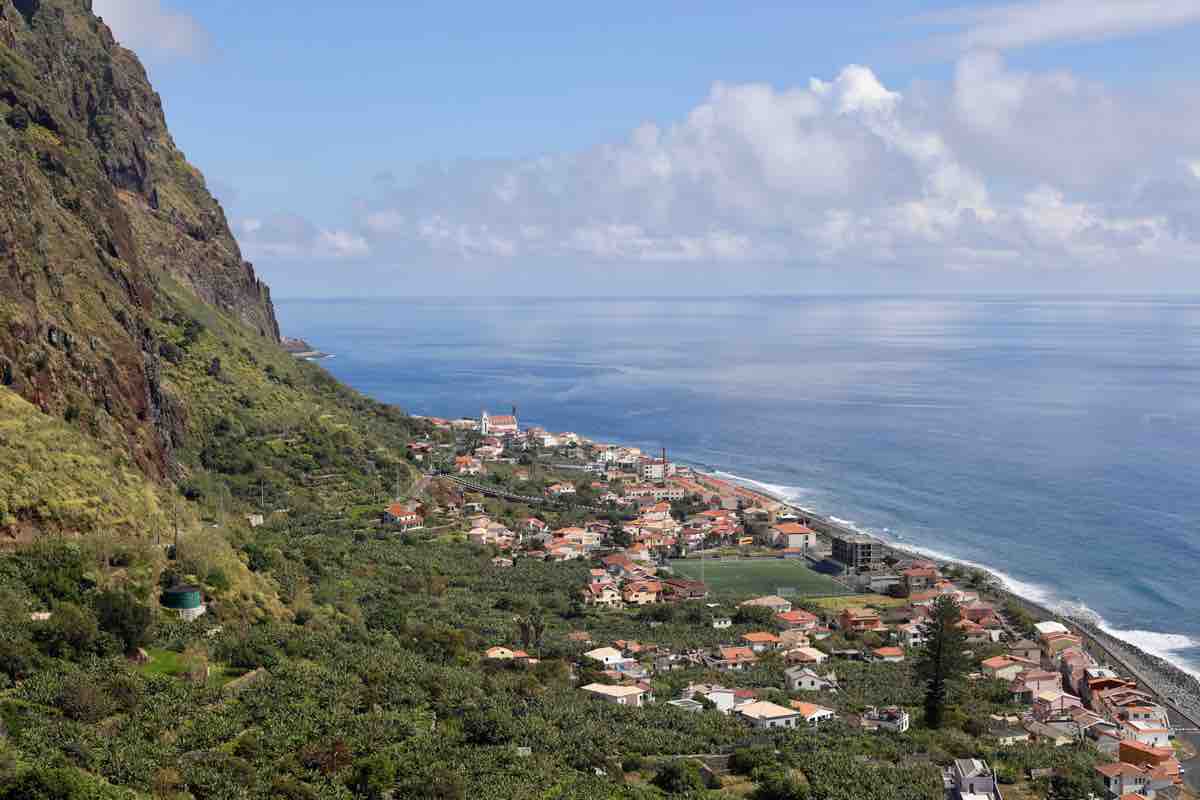[Editor’s Note: For a week in April of 2017, iRunFar’s Bryon Powell and Meghan Hicks traveled to the Portuguese island of Madeira to experience the island and participate in the Madeira Island Ultra-Trail. Below is their story. They also published two albums with additional photos: Days 1-3 & More Time on Madeira.]
Tuesday, April 18, 3 p.m. – Meghan
Transcontinental travel is never easy, but the more I do it, the easier my mind perceives it to be. Yesterday morning at 8 a.m. local time, we lifted off from and left behind last week’s work destination, Sonoma County, California—where we covered the competitive Lake Sonoma 50 Mile—and launched into our next home for a week, Madeira Island. San Francisco to Boston, Boston to Lisbon, Lisbon to Madeira, and suddenly it’s 10 a.m. in our new local time one day later. A bit tired from the long journey, we committed to diving right in and seeing the day through.
We understand the island, part of Portugal but sitting off the coast of Morocco, to be a true trail running haven. It’s playing host this week to its biggest trail event, the Madeira Island Ultra-Trail, which is composed of four races varying in distance from 16 to 115 kilometers in length. Bryon and I are here to experience it and the island ourselves. I am entered in Saturday’s 85-kilometer race, and Bryon the event’s marathon.
As our plane dropped down to land on Madeira and while I napped, Bryon spied a trail tracing its way to the island’s eastern tip. Coincidentally, our home base for the week, a resort complex called Quinta do Lorde, sits just a half mile from the start of that trail. We figure it’s approximately our destiny to make that trail our first Madeira run.
Where Madeira lacks in actual land size—its land area is a scant 309 square miles—it more than makes up for in topography. Wrinkles of land rise and fall steeply everywhere, and the island’s high point at 6,109 feet above sea level hides somewhere out of sight in the clouds above. Our home in Utah sits at 6,000 feet altitude, though, so while our travel-weary legs protest even the first, steep paved-road hill to the trailhead, our hearts and lungs luxuriate in sea level’s oxygenous air.
The sky is nearly clear, the air temperature is in the 70s Fahrenheit, and a fierce wind blows as we make our way out onto Madeira’s final eastern finger of land, a peninsula pointing out into the Atlantic Ocean called Ponta de São Lourenço. In places, the wind shoves me off my intended course and I have to lean in and lower down to maintain position. Based upon the general lack of vegetation, significant rock exposure, and the fact that the swells of the ocean surround us on all sides but one, I’m apt to think that conditions are often rough out here.
This is a popular trail, with hundreds of people scattered about it. With care, we weave among the groups of people, the outcroppings of rough volcanic rock which threaten to tear one’s skin wide open if we were to fall, the trail’s brief-but-steep ups and downs, and the peninsula’s pinch point where it narrows to just a couple-dozen feet in width and with cliffs dropping to the ocean on both sides. (Don’t worry, there are metal cables strung around here. The cliffs are imposing, but you’d have to try really hard to chuck yourself off them.) Soon we are at the trail–and island’s–easternmost point, Pico do Furado. Just a couple cliffy islets are left between us and the Atlantic. The ocean swells bash hard against the cliffs below. You can feel ocean meeting land as much as you hear and see it. Amongst a land and sea of such severity, I slip easily into the sensation of smallness.
We roll back onto the hotel property, click our watches, and gulp water to chase away a strong feeling of thirst. Just six miles run but 2,100 feet of elevation gained and the same amount lost—and all on wee piece of real estate. Yep, I can tell, this is going to be a week of feeling little in big places.
Wednesday, April 19, 9 a.m. – Bryon
Meghan and I start our first full day on Madeira with a filling breakfast at our hotel. It’s warm and sunny and comfortable. We are eager to set off for a day of exploration, so we drive west to the town of Machico before passing through a number of tunnels to Madeira’s less-developed north coast. Over here, it’s rugged. It’s raw. A series of small villages line up along the coast in front of us while a scattering of houses sit in seemingly impossible-to-access areas along the hillsides. In reality, that’s not the first thing to catch our attention. No, that’s reserved for the cliffs, prominences, and beaches that abut the ocean. It’s almost as if we’re in the helicopter, arriving to Jurassic Park in the eponymous movie, looking down upon its vertiginous landscape. Aside from the multitude of small garden plots, vineyards, and banana groves, the landscape is thick with the native laurel forest from which the island derives its name. (Madeira is wood in Portuguese.)
We drive through a town called Porto da Cruz before pulling over atop a hill west of the village of Faial. The view to our east is stunning. A jagged mountain rises swiftly from the sea. Taller mountains tower further inland, but this one appears as if it’s an island in itself that’s made all the grander by its proximity to the sea.
We head downhill to São Jorge, another small town, and leave our rental car behind in a parking lot. We walk sharply downhill on a carefully cobbled carriage way, the wearing of which suggests centuries of use. A few hundreds yards later we turn off on a narrow dirt path and briefly head uphill to a waterfall amidst the thick forest. As we meander downhill some more, I pull off and let Meghan continue down to the coast. I photograph some succulent plants along a cutaway hillside that displays colorful bands of volcanic rocks–which betray the island’s geologic history–and, then, take a seat aside a nearly empty water holding tank to watch nature go by. Back up at the parking lot, we see one of the unusual native fruits, the ‘banana pineapple,’ growing nearby. Later on in the drive, we pull over at a hilltop vista to take in the views and investigate more local fruits.
We lunch at a cliffside cafe maybe 700 vertical feet above the sea. We begin with the local buttery garlic bread, bolo do caco. It’s a quick and hard-to-beat start, and a ubiquitous island appetizer. Meghan and I try to split a pot of caldeirada, Portuguese seafood stew, but it’s huge and we fail to finish. Now, we attempt to undo our food-induced-stupor with some coffees. I take a chino (americano) and Meghan takes a chinesa (latte). All the while we peer out toward a towering cliff that partially ensconces a tiny black beach. A trail bearing tight switchbacks leading ever higher from the beach toward the cliff’s summit simultaneously beckons and intimidates anyone who gazes upon them.
It’s coming up on time to run, but we drive around a bit knowing that an immediate run would be unpleasant, if not impossible, for our full bellies. Driving was a breeze along the motorways early in the day and easy enough as we wound through the small towns along the north coast. However, things turn briefly tense on ER101, the old road that preceded the current motorway in its ring of the island. Heading west, we’re on the ocean side of this windy road cut into the cliffside. Often enough, a low stone wall is all that separates us from the ocean 1,000 feet blow. The road is not much wider than one car in places, which makes it necessary to watch out for oncoming cars far in advance. Fortunately, traffic is light. An upside of these stressful minutes is a waterfall landing directly onto the road. Fancy a Madeiran carwash?
Shortly after popping back over to the island’s south side–this time via a narrow road that goes over the island’s crest instead of through it via tunnels–we pull over aside a trail Meghan’s scoped out. After a bit of prep, we head east for two relatively flat miles through a scented eucalyptus forest. Then, out of nowhere, we encounter a nearly abandoned hamlet. It’s tempting to call it completely abandoned, but on our return trip past here a couple hours later, we would notice some recent garden planting and younger fruit trees, signs this remote collection of buildings isn’t frozen in time.
Not long after the leaving the tiny village, we begin a two-mile climb that’s ever steeper. The view at the top is worth it. Huge vistas to the south toward the ocean as well as a yet-to-be-seen ridgeline and pass to the northeast. The run back to our car–now among the gorgeous light of the golden hour–is as beautiful as it is uneventful.
Saturday, April 22, 7 a.m. – Meghan
It’s going on 7 a.m. in the still-asleep village of São Vicente, which sits a few miles off and 500 feet above Madeira’s northwest coastline. This is the start line of the Ultra race that’s part of the Madeira Island Ultra-Trail.
As many years as I’ve now done things like this, I remain intimidated by the statistics of today: almost 53 miles, 15,400 feet of climb, a similar amount of descent, and a day’s worth of crisscrossing the island’s poky east-west spine before coming to rest at the race’s finish line in the town of Machico, at the island’s east end. I have decided that my worst-case scenario is a 15-hour day, so I have divided that many hours worth of running fuel between the pack on my back and the drop bag which should meet me at the race’s halfway point, also its highest point. It’s not the distance that frightens me—two months ago I opened my season with a similarly distanced race—it’s the amount of vertical change this race involves and how that will make my quadriceps and calf muscles feel. But I’ve got a running goal that involves a lot more vertical than I’ll see today, so I hope that this race will be the stepping stone between where I am now with my fitness and where I’d like to be in a month.
We competitors are sent off into the pre-sunrise, headlamps and hearts alighted as we march immediately into the race’s first climb. Up we go, up paved and dirt roads, up agricultural trails dividing fields of fledgling potato plants, up. We watch the sun kiss the cliffs many thousands of feet above, where we will ourselves be in a few hours’ time.
Just an hour or so into the race, we join the route of the 115-kilometer distance race, which began last night at midnight, and join forces with the throngs of women and men who have been going strong for eight hours already. The set-up, however, is not ideal. There are many of us and many of them, and we are traveling at different paces. For the next 15 miles or so, I play the somewhat uncomfortable game of passing runners from the longer race. Some of these runners are happy to share space and views and kindly words, but others have already entered into the pain cave that is somewhat inevitable in a race as long and as difficult as theirs. I suppose this is one of the problems of hosting a massive weekend of racing on shared trails?
Madeira’s low country is a place of curiosity for me, where most of the homes and agricultural fields of the islands’ inhabitants lie, so our lower-country meandering offers endless observation opportunities. More than 250,000 people call Madeira their home, what amounts to a minute piece of real estate amidst a great expanse of ocean. Lush climate seems to mean good soil, but steep topography clearly creates the challenge of keeping that soil in place. Nearly the entire island is terraced. Terrace upon terrace upon terrace, as high and as low as the eye can see. I understand that most of these were built by hand hundreds of years ago but I can only presume they require constant upkeep against the forces of gravity and weather, not an engineering marvel but an engineering miracle if you ask me.
Ultramarathon racing is something of a personal dichotomy. I so love the places this niche sport can take you—from the people with whom you develop friendships courtesy of these random community gatherings to the places you can choose to race—but I also have learned to yearn after the alone time that these races afford me. Our race encounters Madeira’s highest country as we tick over the 20-mile mark and engage with an almost-4,000-foot climb to the island’s high point, Pico Ruivo. Sure, there are other people on this trail, racers and recreators alike, but now I am mostly in conversation with myself as I rise.
I am also wicked thirsty. Carrying a bottle with a small filter, I have been helping myself to all kinds of water sources trailside. But here is the hottest part of the day and what seems like the driest stretch of trail. I get desperate and dive into a dingy puddle, collect enough water to make it four more miles to the aid station atop Pico Ruivo, earn funny looks from a couple other racers, and putter on.
It’s likely that I’ll never in my life see another trail like what I experience in the three miles between Pico Ruivo and Pico do Arieiro. Tunnels from one side of the mountain to the other so dark you need a flashlight to run though, metal ladders pinned to cliff faces, trails blasted out of impossible rock towers. Clouds waft on and off the mountain, obscuring the view to just feet and then opening it to miles. It takes an hour for me to connect these two mountain peaks—in part because of a massive amount of climbing and descending that’s in this section, but also because you can’t really run and take in the landscape on such a precarious trail. If you want to let the view really soak into you, you have to stand still and then let your eyes wander. I am normally at least cognizant of the passage of time in a race, and sometimes downright competitive, but in these moments my singular desire is to simply see and feel Madeira.
In the end, I complete the race in 13 hours and 36 minutes, all in one piece. No blisters, no overuse problems. Tired, sure, but not broken. I feel content. That said, I choose a poor recovery path, one that involves too many hours of sitting in a chair in a hot and overcrowded restaurant near the finish line. I don’t eat enough and certainly don’t drink enough and it’s something like three hours after finishing when I actually consume my dinner. This sort of thing is part and parcel to racing in a foreign country, among the many circumstances you can’t even partially control in doing so. And let’s face it, hanging out in an energetic, local restaurant on a weekend night is just plain fun. But I do kick myself for not stowing some food and drink in my finish-line drop bag, something with enough protein and carbohydrates to have launched the recovery process ahead of waiting so long for restaurant delights. I can’t know it quite yet, but my muscles will protest this poor recovery for a couple of days. Live, try to learn, and run on.
Saturday, April 22, 11 a.m. – Bryon
The dreamy 11 a.m. start time of the Marathon race that’s part of the Madeira Island Ultra-Trail allows me to enjoy a leisurely, reasonably timed breakfast at my hotel before catching a taxi with another runner over to the race finish in Machico, just a few miles away. From there, we join a few hundred other runners on buses for the windy ride up the mountainsides to the start some 4,300 feet above sea level.
We’re at the start more than an hour before the race, so I take a seat in a nearby building to relax. Fifteen minutes before the start I head to the corral, where I encounter loud music, people dancing, and other sorts of excitement. It’s not my thing, but there are plenty of others simply milling about. Two minutes after the start we’ve passed most of the cheering fans and the music fades behind us. It now feels like a subdued trail race despite the nearly 600 starters and recently raucous scene. I feel at home as we climb for three miles through mostly open hillsides to the race’s high point around 5,200 feet altitude. Along the top, I cruise over wide-open grasslands speckled with occasional gorse shrubs in yellow bloom or small patches of trees. It’s hardly the landscape that I’d expect atop a volcanic island. I’d prepared myself for barren rocks and abrupt cliffs. The infinite views are enthralling. I anticipate this to be the highlight of my race, but that won’t be the case.
After a few cruisy miles up high, I descend moderately technical trails that transition from grassland to forest down to the Ribeiro Frio aid station. From there, a brief road section leads us to a grunt of an uphill. It’s something like 1,000 feet of climb in a bit over a half mile, which I assume will lead me to the next high point. Instead, I find that there is another almost two miles and 1,000 feet of climbing to the race’s second and final highpoint. During all of this, we move from thick laurel forest throughout the steepest bit, briefly through some more open grasslands, before ending up in a pine forest.
From there, the course descends 2,600 feet over five-ish miles. Some of this is on singletrack that’s frequently along Madeira’s levadas, the irrigation channels which distribute water for irrigation purposes about the island. Often adjacent to singletrack, doubletrack, or a cement path, these levadas significantly add to Madeira’s trail system. There’s also a fair bit of descending on rocky doubletrack. As I’ve done throughout the race, I strike up conversation whenever my pace and language skills fall in sync with another runner.
Not long after Portela at 15.5 miles, I’m at what might become my favorite part of the race. It’s gentle undulating singletrack winding its way through a lush, but airy forest. A world apart, the flow of this stretch somehow reminds me of the trail running I did as a kid in the forest of central New Jersey. That ends after a short rise leads to a precipitous descent. Like 1,000-feet-in-a-little-over-a-half-mile steep. There are only a few rocky sections that warrant slowing down, but the entire descent is steep and sometimes slick enough to advise additional care. This descent takes place above Madeira’s northeastern coast, of which views occasionally pop through the forest. I sneak glances toward the cliffs and the ocean below when I can.
It turns out that there is little need for me to play peekaboo with the vistas as I descended as the next three miles are chock full of jaw-dropping views. Imagine snaking in and out of mountain canyons on a trail cut into a cliffside hundreds of feet above the ocean. At one point I stumble on a rock while trying to shoot photos–I took 358 of them during the race!–on the move. I decide to be a bit more cautious going forward.
It’s during this stretch that Joakim Röstlund the Swede catches me. We’d run together previously around mid-race. We run together some more before he moves on as we skirt the island’s north edge and, then, gradually climb to a pass. Now we descend a short technical stretch from the island’s backbone and back onto the island’s south side, and I catch up to Joakim again. We team up and run the levadas around the east end of Machico for three miles until a quick trail and, then, road descent to the beach where we finish. Altogether, it’s a fantastic run under great weather, with great scenery, amongst great people. One I’d not hesitate to do again.
[Author’s Note: Here’s the route.]
Sunday, April 23, 2 p.m. – Bryon
For as long as Meghan’s known me, she’s probably only seen me relax a handful of times, as I’m nearly always working with running and the rest of life’s details taking up the slack. Indeed, she probably thought it was no longer possible until I showed her otherwise while we stayed for two nights in a tiny cabana with no wifi and little cell signal on the Portuguese coast after last year’s IAU Trail World Championships. It with this in mind that I schedule Sunday as a day to relax. A bit of morning work–interviewing the Madeira Island Ultra-Trail winners Andrea Huser (interview) and François D’haene (interview)–pushes this back until early afternoon, but it’s a date.
Here at the Quinta do Lorde hotel, a small village in its own right that sits on the southern coast of Madeira, a massive patio overlooks the Atlantic Ocean. We climb into some oversized lounge chairs over which we unfurl a huge umbrella. We lay back and listen to waves roll in, pushing the beach’s black volcanic rocks up the shore before they roll back toward the sea with each wave’s retreat. We’re cozy beneath the umbrella with warm temperatures and a light breeze and with direct sunlight trending toward hot.
Meghan catches a short nap while I pull out a copy of Feet in the Clouds, a book about fell running in England by Richard Askwith, which is the next stop on our tour. While it’s only a couple hours, the peaceful ocean-side environment is just the rejuvenation we need after a few hectic weeks. My thoughts shift from the past and the future to the present. With that shift, my stress and freneticism melt away. I enjoy the moment.
Sunday, April 23, 7 p.m. – Meghan
We roll into the parking lot of Stephanie Case and Belinda Holdsworth’s hotel. Yesterday, Stephanie ran the 115-kilometer race and Belinda the 85k, like me. In a few minutes, the four of us will sit down to a bountiful seafood-based and celebratory dinner at a restaurant called Atlantis, in the village of Caniço de Baixo, on the island’s south side.
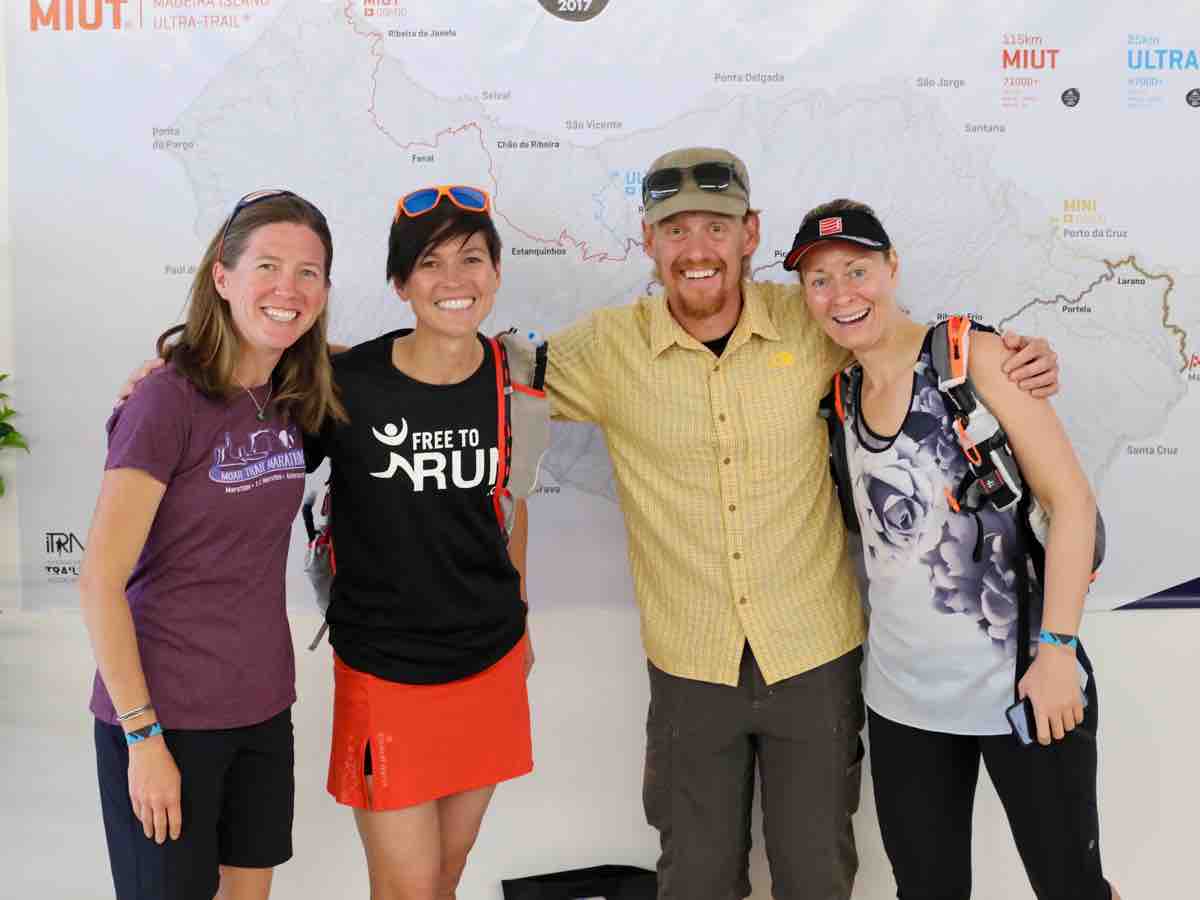
At the Madeira Island Ultra-Trail check-in with friends a few days before. From left to right is Meghan Hicks, Stephanie Case, Bryon Powell, and Belinda Holdsworth. Photo courtesy of iRunFar.
But first we have to get there, which is not a small ask for Stephanie, who has almost non-functional quadriceps thanks to yesterday’s endeavors. She walks by swinging her legs out to the side from the hips in lieu of a regular leg swing. Once she gets going she really motors, so fast on the downhill I fear she might fall over. We are grateful that the restaurant has an elevator t0 lower us from street level down to where it perches clifftop over the ocean. By the time we sink into chairs on the restaurant’s patio, I am laughing so hard that my abdominal muscles ache. I can feel it: tonight is a good night.
We dive into the menu and order approximately everything. When the waitress takes our order, we come at her hot and heavy, and she writes furiously to keep up. It’s a five-minute ordering parade with each of us making additions and changes. When it’s over, I’m not actually sure what we ordered, but we begin our hungry wait for the feast.
Appetizers first. Limpets, which seem like Madiera’s equivalent of mussels, what Bryon and I learned last year are a common appetizer on mainland, coastal Portugal. The limpets are cooked in their shell with oil, garlic, and lemon. They are delicious. Prawns, cooked and then cooled, served shell on and with lemon. A cold octopus salad, with greens, onion, a little fruit, and lemon. Always a lemon with seafood on Madeira. Belinda and Stephanie try a fish soup, made with a tomato base. Parsley floats in the liquid, as does several kinds of vegetables.
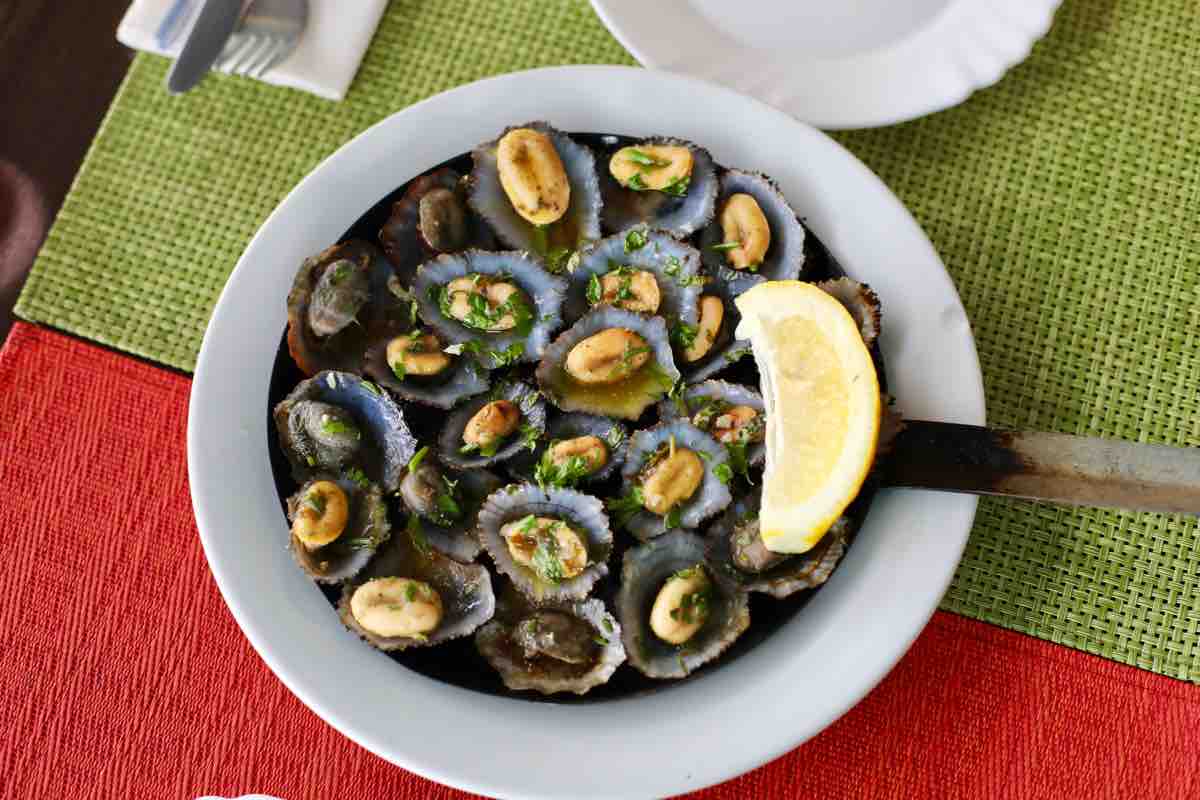
An example of a limpet appetizer, cooked shell-on in a skillet over heat. Photo: iRunFar/Meghan Hicks
Had we not run as much as we did yesterday, our first course would be plenty for a meal. But our appetites are massive and the main courses shortly follow. We all eat grilled white fish, one of the most common foods on Madeira. The species isn’t usually specified on restaurant menus, and it’s cooked and served as either the whole fish or in fillets. The white meat is soft and yet still flaky, light in the mouth and delightful. Our main courses are accompanied by a couple kinds of potatoes, one of the main carbohydrate staples on Madeira. Through dinner we sip on vinho verde, young and slightly effervescent white wine from mainland Portugal.
We swear off dessert initially, “We’re too full!” “That’s enough!” “Oh no, I can’t do it!” But it’s just a few minutes until we cave and order several different kinds. Coffee and tea, too—decaf though, we’re all whooped from racing and want to sleep well tonight.
Hours of eating and drinking later, our very own seafood bonanza, we are full and as stiff as Stephanie from sitting still for so long. We are a sight to see as we limp our way through the bar and exit the restaurant. Thankfully, no one’s milling around on the street to watch us grunt and heave and tow each other up the hill and back to the car, laughing all the way. It is a perfect night to finish a perfect today.
Monday, April 24, 12 p.m. – Meghan
Earlier this morning, I awoke, having fully forgotten about that 52-mile race two days ago. Pulling back the covers and cranking my legs toward the edge of the bed, my quadriceps squealed and threatened to seize. It’s a nice case of DOMS, delayed onset muscle soreness, and all day my legs will grieve me as we meander the island. For all the laughing I did at Stephanie yesterday, I am now paying my dues.
Bryon and I had work to do this morning, such that we don’t pull out of our hotel until midday, bound for the Mercado dos Lavradores, the worker’s market, located in Madeira’s capital city of Funchal, where various food products are sold. After nearly a week of exploring Madeira’s quieter towns and villages, the traffic, number of people, and general rush of Funchal shocks me. I struggle to muster the energy for joining the energetic bandwagon. We enter the fish market side of the building first, but this show is already over for today. I suspect the fish gets sold and bought on the earliest side of things, as fisherfolk sell their catches to local restauranteurs and store owners. Just a few fish remain here and there, but the heavy odor of raw fish lingers in the air.
We pass through to the agricultural side of the market building, which is three stories tall and has a massive, open air courtyard. It’s divided into dozens of individually operated booths. We sample fruits and check out the vegetables, buy and munch on some figs and sugar cane, and mostly people watch. We wander among a few other little shops, which sell Madeiran wine and liquor, as well as alcohol that’s been brought in from abroad. As markets go, I find this one interesting but a bit tourist-oriented. I suspect that very little local trade happens here.
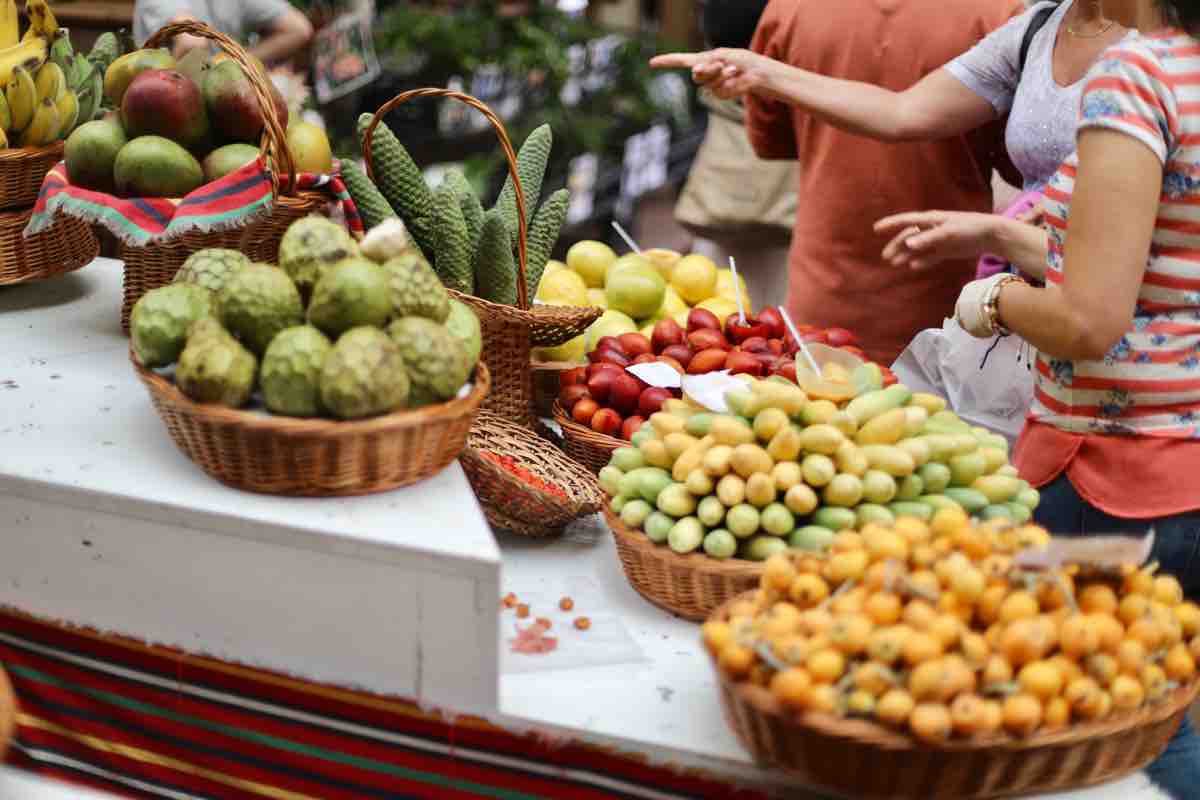
A Mercado dos Lavradores fruit stand selling some of Madeira’s unique fruit. Photo: iRunFar/Bryon Powell
After leaving the market, we duck into a coffee shop, order drinks, people watch one of Funchal’s main drags, and devise a plan for the rest of the day. We both agree that the energy of the capital city doesn’t match our own–and my quadriceps require a slow-motion crawl anyway–so we bail and drive west along the island’s south coast. Mid-afternoon already, we don’t have too much time, but I’d read about a couple tiny, quiet seaside villages on the island’s south side, which sit right on the ocean but below many-thousand-foot-tall cliffs, detached from the rest of the island save for a couple nutty roads switchbacking in and out of them. We type of one of them, Jardim do Mar, into Google Maps and forge out.
It’s a hot and humid afternoon and only the faintest of breezes blow. We park our car in a car park at the edge of town and walk in. The past and the future mixes here, hard. I can feel it straight away. Tourists wandering, locals moving to and fro. A mix of hundreds-year-old historic buildings and new tourist lodgings. Narrow, cobbled passageways painted anew in bright colors. Walls with new replacement tiles mixed in amongst others that have to be at least three times my age. A positively strange promenade right by the ocean, which has been built as a protective sea wall for the town, but is odd in how modern it looks with agricultural fields abutting it. We are here 90 minutes and I can see and feel the pull of the past and the future on Jardim do Mar.
Our time here is coming to its end, and tomorrow we’ll fly on to our next destination, London, England. I nurse my sore legs along the promenade, my thoughts flying around at a much quicker pace. I am struck by the sensation that a week is altogether a lot of time and a little time here, that I’ve at once learned too many things about Madeira—so many that I won’t remember them all—and too few things–I can’t really get a grip on what this island is all about.
It would take several more weeks, I think, to better understand this place. More time in little villages like this one, more time in the tiny markets, more time watching farmers weed their terraces and repair their irrigation systems, of walking the levadas to see all the people and places they connect, of going into the eucalyptus forests and going quiet, of letting the high-country clouds completely envelop you, of waiting for the rain just to smell what damp volcanic soil smells like, of stopping again and again to sip coffee and watch what goes by, of watching gulls play on the trade winds and follow fishing boats into the harbor, of learning how to cook seafood the Madeiran way, of asking a shop owner, “What’s this? And how about this?”
I am content with our little taste, though, of knowing that there is much unknown that I don’t know, of leaving and still wanting more.
Call for Comments (from Meghan and Bryon)
- Have you been to Madeira? Can you share a story about your time on the island?
- Have you spent time trail running or otherwise exploring the island’s trails? If so, what different parts of the island’s biology, geology, geography, topography, and culture did you experience via trail?
- Have you participated in one of the events of the Madeira Island Ultra-Trail?

